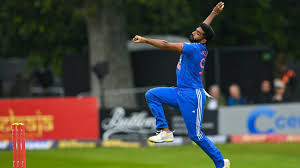In decades gone by, this article, a stock-take of South Asia’s pace-bowling output, would have started with Pakistan, cast a sympathetic eye towards India, skimmed patronizingly over Sri Lanka, made little mention of Bangladesh, no mention of Afghanistan, then returned swiftly to the high-octane, long-hair-blowing-in-the-breeze, bursting-through-the-tv-screen-into-our-fantasies world of Pakistan fast bowling.
Other teams might have had the occasional great fast bowler, but Pakistan had Sarfraz Nawaz, then Imran Khan, then Wasim Akram and Waqar Younis, and then Shoaib Akhtar and Mohammad Asif, so really one of the richest bloodlines in the sport.
They have still got it, of course. Pakistan is still the South Asian home of the fast bowler of the ancient scriptures – tall, fast, muscular, with strong wrists, braced front legs, raining down late movement, and blowing imaginations upon squalls of attitude. But the region’s other teams have begun to set up what could be production lines of their own. They haven’t followed Pakistan’s lead, exactly – they have other things that work.
The Legacy of Pakistani Fast Bowling
The Golden Era: Sarfraz Nawaz to Shoaib Akhtar
Pakistan’s fast bowling legacy began with Sarfraz Nawaz, known for his mastery of reverse swing. He laid the groundwork for future legends like Imran Khan, who brought an aura of charisma and leadership. Imran was succeeded by the magical duo of Wasim Akram and Waqar Younis, whose devastating pace and swing revolutionized fast bowling. The legacy continued with Shoaib Akhtar, the “Rawalpindi Express,” whose blistering speed made him a global sensation.
Modern Era and New Talents
In recent years, Pakistan has continued to produce fast bowling talents such as Mohammad Amir, Hasan Ali, and Shaheen Afridi. These bowlers have upheld Pakistan’s tradition of producing world-class fast bowlers, combining speed, skill, and flair.
India’s Rise in Pace Bowling
From Spin-Dominated to Pace-Inspired
India, traditionally known for its spinners, has seen a significant transformation in its pace bowling department. The change began in the early 2000s with bowlers like Zaheer Khan and Javagal Srinath, who paved the way for the current generation of fast bowlers.
The New Generation: Bumrah and Company
Today, India boasts a formidable pace attack led by Jasprit Bumrah, known for his unorthodox action and deadly yorkers. He is supported by talents like Mohammed Shami, Ishant Sharma, and emerging stars like Navdeep Saini and Mohammed Siraj. This new generation has helped India compete on equal footing with other top cricketing nations, especially in conditions favoring fast bowling.
Sri Lanka’s Steady Progress
Early Challenges and Breakthroughs
Sri Lanka’s journey in pace bowling has been slower but steady. Early on, the country struggled to produce quality fast bowlers consistently. However, bowlers like Chaminda Vaas, with his precision and swing, provided a solid foundation.
Current Talents and Future Prospects
In recent years, Sri Lanka has seen the emergence of bowlers like Lasith Malinga, whose unique slingy action and toe-crushing yorkers earned him international fame. The current crop, including Dushmantha Chameera and Lahiru Kumara, shows promise for the future.
Bangladesh’s Emerging Fast Bowling Scene
A Late Start with Rapid Growth
Bangladesh, traditionally known for its spin-friendly pitches, has recently started focusing on developing fast bowlers. This shift is evident with the rise of talents like Mashrafe Mortaza, Mustafizur Rahman, and Taskin Ahmed.
Building a Pace Legacy
The emphasis on pace bowling in Bangladesh is a relatively new phenomenon, but with proper infrastructure and coaching, the country is making significant strides. The future looks bright as young fast bowlers emerge from domestic circuits and age-group cricket.
Afghanistan’s Rapid Ascent
A New Entrant with Raw Talent
Afghanistan, the newest entrant in international cricket, has already made a mark with its fast bowlers. Despite limited resources, the country has produced exciting talents like Hamid Hassan and Naveen-ul-Haq.
Harnessing Potential for Future Success
Afghanistan’s fast bowling potential is immense, and with the right support and development programs, it could become a force to reckon with in the near future. The raw talent and passion for the game are evident, and it’s only a matter of time before they make significant strides.
Comparative Analysis of South Asian Pace Bowling
Pakistan: The Pace Bowling Powerhouse
Pakistan remains the undisputed leader in producing fast bowlers. The country’s cricketing culture, combined with natural talent and effective training programs, continues to churn out exceptional pace bowlers.
India: A Growing Force
India’s transformation from a spin-dominated attack to a formidable pace unit is remarkable. The country’s investment in fitness, training facilities, and focus on nurturing fast bowling talent has paid off handsomely.
Sri Lanka and Bangladesh: Steady Progress
Sri Lanka and Bangladesh are making steady progress in developing fast bowlers. While they may not yet match the depth of Pakistan or India, the emergence of new talents and focused development programs indicate a positive trend.
Afghanistan: The New Challenger
Afghanistan’s rise in international cricket and the emergence of fast bowling talents are impressive. With continued support and development, Afghanistan has the potential to become a significant player in South Asian fast bowling.
The Future of Fast Bowling in South Asia
Investment in Infrastructure and Training
For South Asian countries to continue producing world-class fast bowlers, investment in infrastructure and training is crucial. This includes building state-of-the-art training facilities, hiring experienced coaches, and creating pathways for young talents to develop.
Adapting to Changing Conditions
Adapting to different playing conditions is essential for fast bowlers. South Asian countries need to ensure their bowlers are versatile and can perform in various conditions, from the subcontinent’s flat tracks to the seaming and swinging pitches abroad.
Fostering a Competitive Environment
Creating a competitive domestic cricket environment is vital for nurturing fast bowling talent. Regular exposure to high-quality domestic competitions helps bowlers refine their skills and prepares them for international challenges.
The Role of Mentorship and Legacy
Experienced bowlers mentoring the next generation can have a significant impact. The legacy of great fast bowlers in South Asia provides inspiration and a knowledge base for young talents to learn from and aspire to.
South Asia’s fast bowling landscape has evolved significantly over the decades. While Pakistan remains the traditional powerhouse, other countries like India, Sri Lanka, Bangladesh, and Afghanistan are making impressive strides. The region’s investment in infrastructure, focus on training, and the emergence of new talents promise an exciting future for fast bowling in South Asia.








